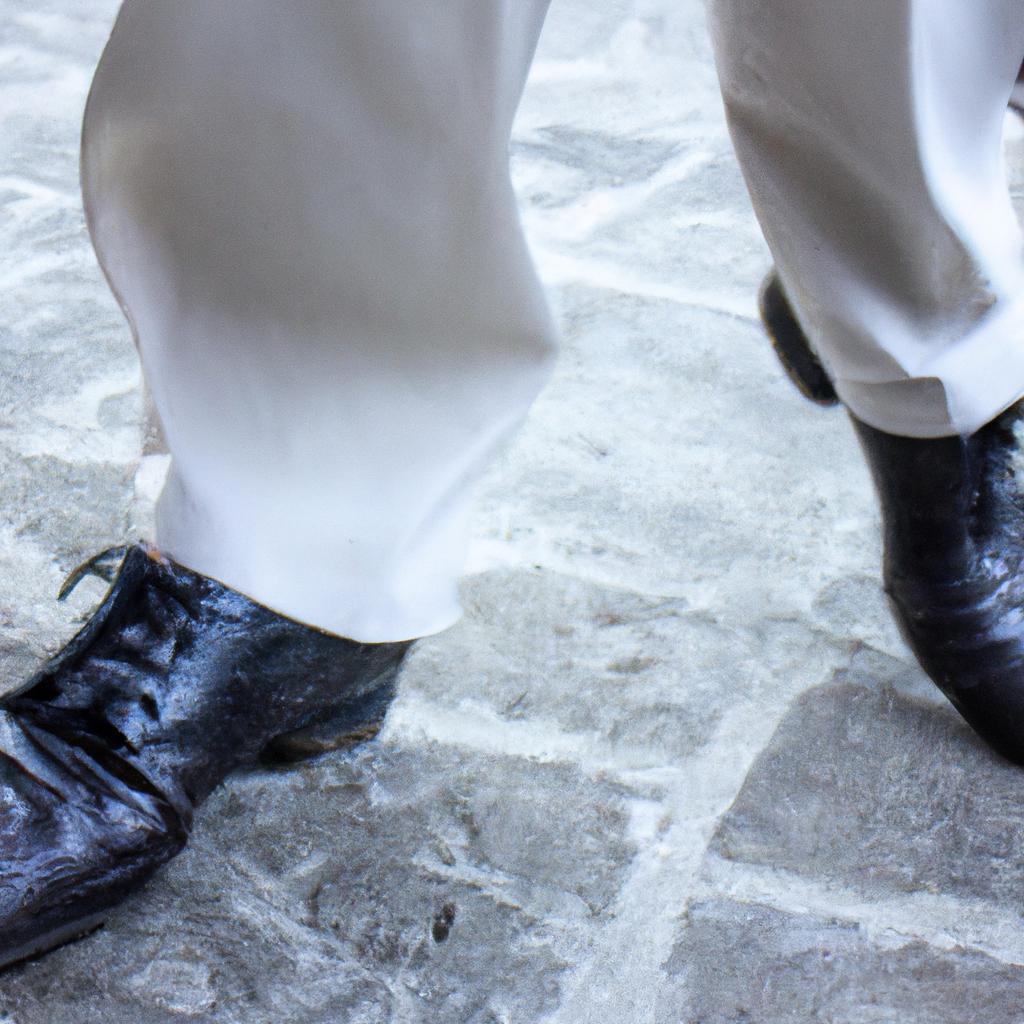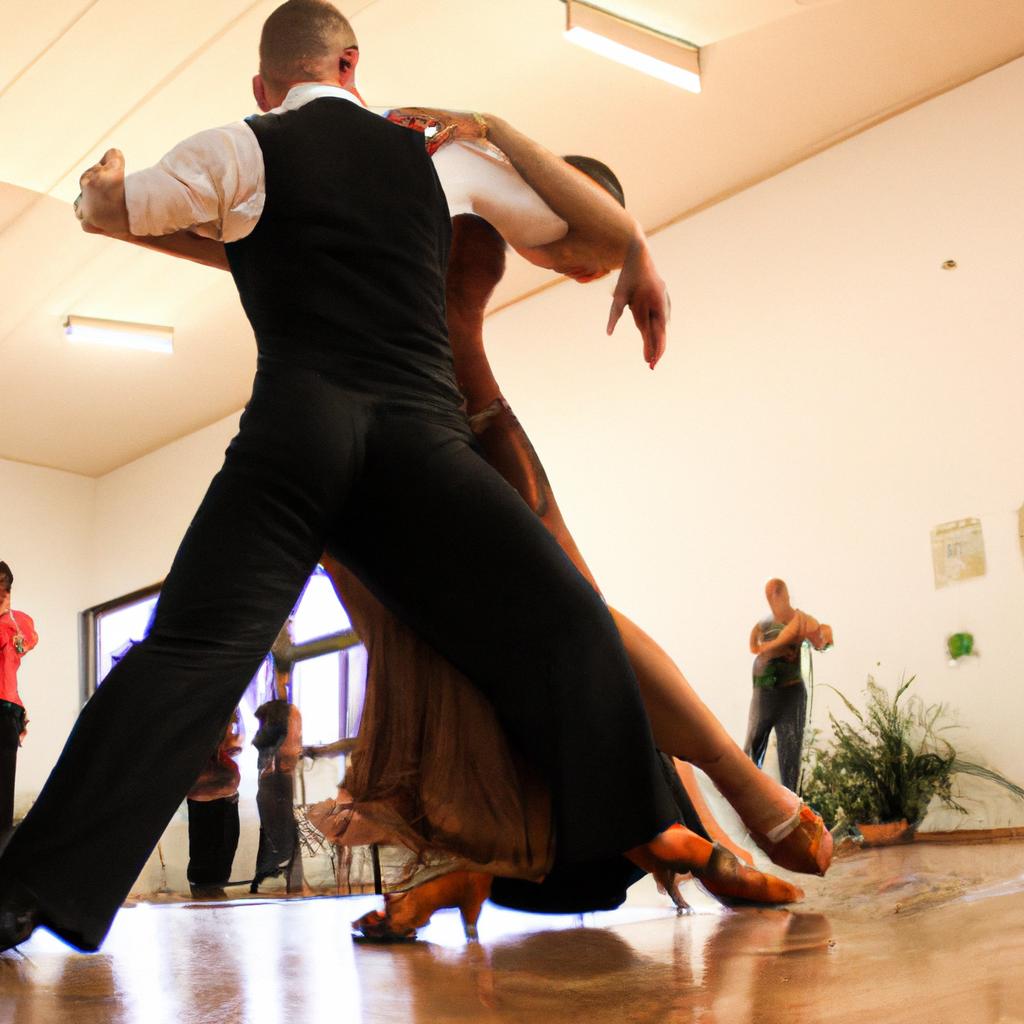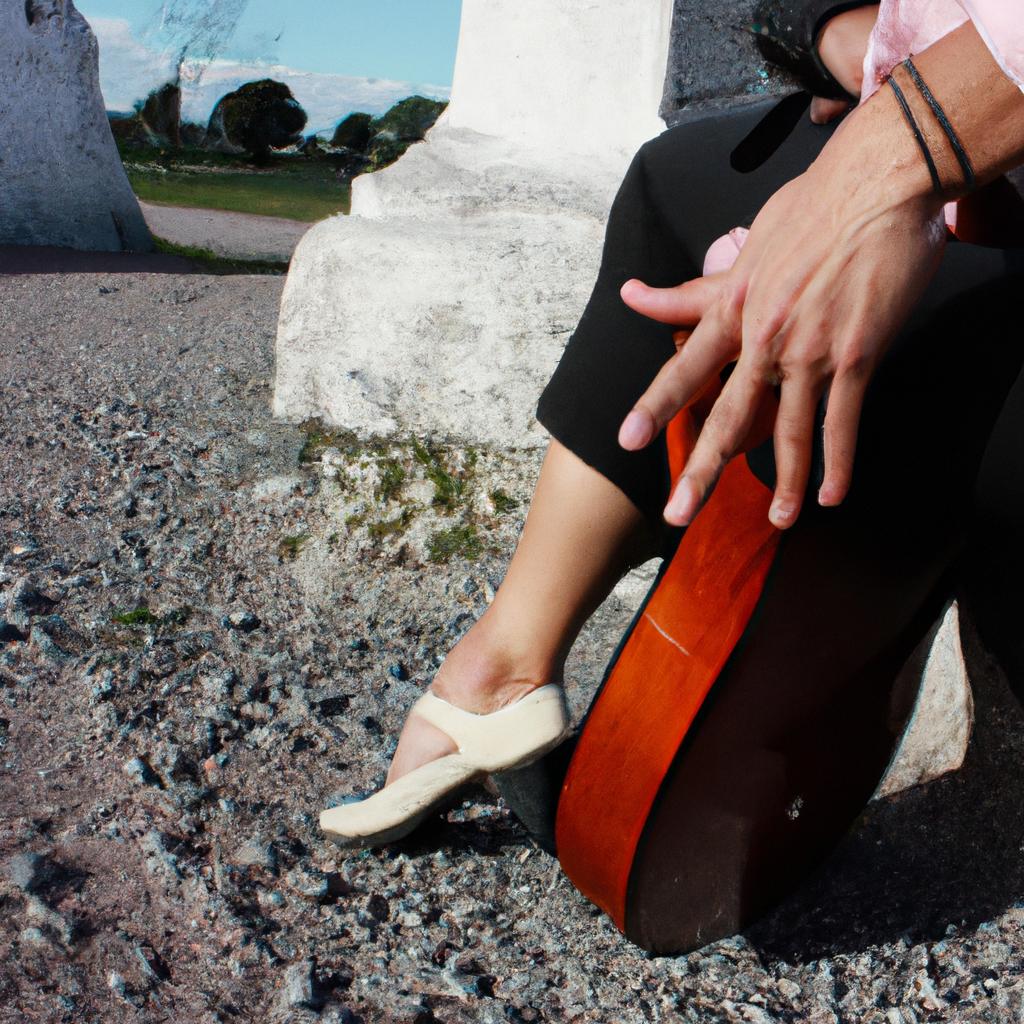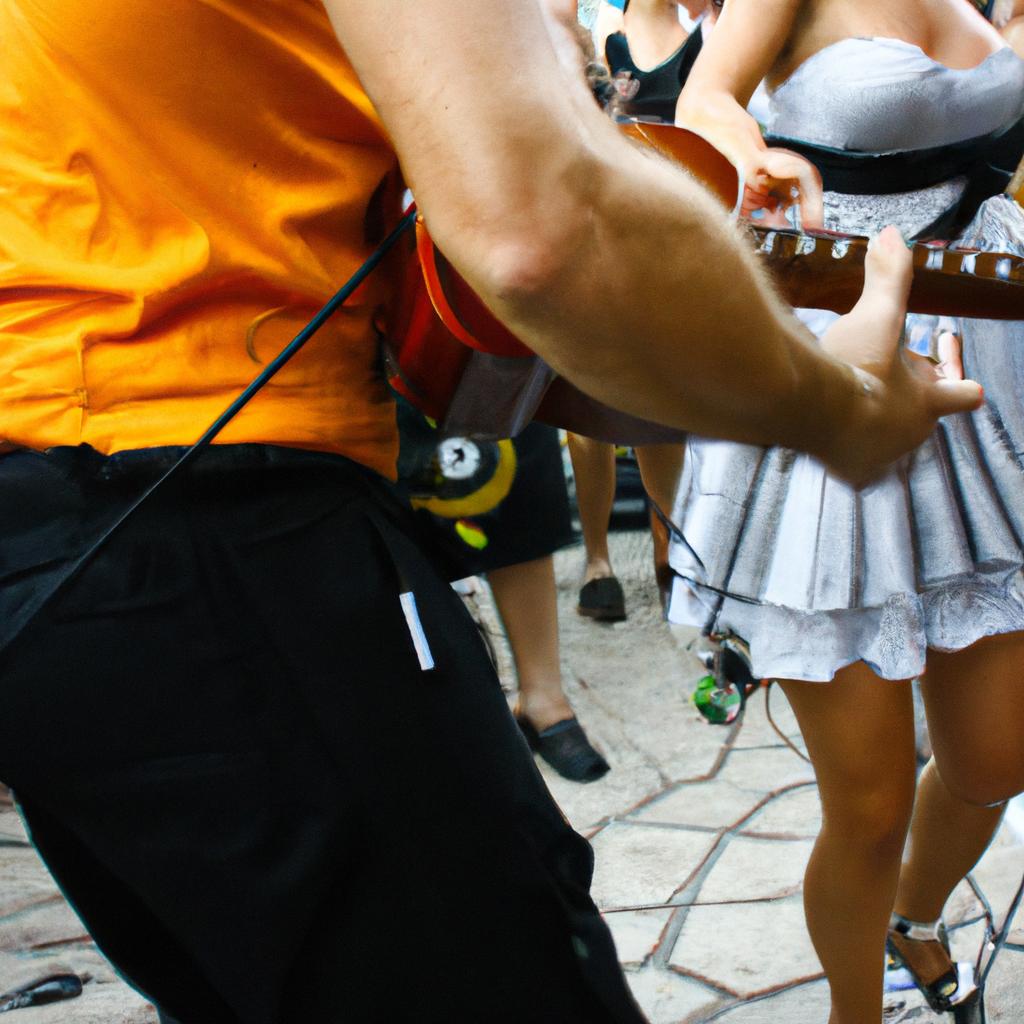In the realm of dance, tango stands out as a captivating and dynamic art form that has been evolving over centuries. With its roots in the cultural melting pot of Buenos Aires, Argentina, tango is not only known for its passionate movements and intricate footwork but also for its unique fusion of music and dance. This article explores the techniques employed by masterful tangueros in achieving a seamless integration between the instruments and dancers within the tango context.
To illustrate this concept, let us consider an imaginary scenario set in a traditional milonga, a social gathering where tango aficionados come together to share their passion for this expressive dance style. As the musicians begin playing their melancholic melodies on violin, bandoneon, piano, and guitar, one particular couple takes center stage. Through their skillful execution of synchronized steps and intimate connection with each other’s bodies, they create a mesmerizing harmony with the live music. Their movements effortlessly follow every nuance of the melody – from sharp staccatos to lingering legatos – as if translating notes into motion. It is through such mastery of technique that these dancers embody the essence of tango: a harmonious blend of sound and movement that transcends individual expression to become a shared experience between dancer and musician.
In tango, the dancers aim to become one with the music, allowing their bodies to respond instinctively and intuitively to the rhythm and emotions conveyed by the instruments. Through years of practice and dedication, they develop a deep understanding of the musical structure and phrasing, enabling them to interpret and express it through their movements.
The couple in our scenario achieves this seamless integration between dance and music by focusing on several key techniques. Firstly, they maintain a strong connection with each other throughout the dance. This connection is not just physical but also emotional and energetic. It allows them to communicate effectively with subtle cues, ensuring that their movements are perfectly synchronized.
Secondly, they have a keen sense of musicality, which means they can identify different musical elements such as tempo changes, accents, and pauses. By paying attention to these nuances, they can accentuate certain steps or create moments of stillness that enhance the overall performance.
Furthermore, the dancers utilize specific tango techniques such as embellishments and improvisation to complement the music. Embellishments are intricate footwork or body movements that add flair and personal style to the dance. They often correspond with particular musical phrases or accents, enhancing the connection between dancer and instrument.
Lastly, these masterful tangueros have extensive knowledge of traditional tango compositions as well as contemporary interpretations. This familiarity allows them to anticipate musical patterns and adapt their movements accordingly. They may choose to emphasize certain instruments or melodic lines within a song or explore different dynamics depending on the mood being portrayed.
By incorporating all these techniques into their dance, our imaginary couple creates an immersive experience for themselves and those watching them at the milonga. Their ability to seamlessly integrate with live music elevates their performance from mere movement execution to an artistic expression deeply rooted in tango’s rich cultural heritage.
Indeed, mastering this art form requires both technical proficiency in dancing as well as a profound appreciation for its musical origins. Through their dedication and passion, tango dancers can achieve a captivating harmony with the music, bringing to life the true essence of this beloved dance style.
Understanding the Fusion of Tango and Instrument
Imagine a tango performance where the passionate dance movements are perfectly synchronized with the soulful melodies of an instrument. This harmonious fusion between tango dancing and instrumental music is captivating to both performers and spectators alike. In this section, we will explore how tango and instruments come together to create a unique artistic expression.
To comprehend the essence of this fusion, it is essential to recognize that tango itself is a multifaceted art form. Originating in Argentina during the late 19th century, it encompasses not only dance but also music and poetry. The synergy between these elements allows for endless possibilities in terms of creativity and interpretation.
The integration of instruments into tango adds another layer of complexity and depth to its already rich tapestry. For instance, let us consider the case study of Maria, a skilled pianist who has mastered the techniques required to accompany tango dancers. Through her playing, she enhances their movements by accentuating specific beats or adding subtle variations to evoke different emotions within each step.
To better understand how this fusion impacts both performers and audiences on an emotional level, consider the following:
- It creates a sense of connection: As dancers move gracefully across the floor, guided by precise musical cues from accompanying musicians, a profound bond forms between them. This connection transcends individual skill sets and transforms the entire experience into something greater than the sum of its parts.
- It evokes passion: By uniting tango’s inherent sensuality with live instrumentation, performers have the power to ignite intense emotions within themselves and their audience members. The raw energy emanating from every note played amplifies the ardor present in each movement.
- It fosters improvisation: Tango is known for its improvised nature, allowing dancers and musicians to adapt spontaneously to one another’s rhythms and expressions. This fluidity enables moments of serendipitous beauty that captivate observers.
- It showcases artistic collaboration: The fusion of tango and instruments highlights the significance of teamwork and cooperation in producing a seamless performance. Each participant brings their unique talents and skills, contributing to a cohesive whole that is both visually stunning and musically captivating.
In exploring these facets of the fusion between tango and instrument, we gain insight into the dynamic relationship between movement and sound. In the subsequent section, “Exploring the Techniques of Tango Instrument Playing,” we will delve deeper into the specific techniques employed by musicians to enhance the dance experience without missing a beat.
Exploring the Techniques of Tango Instrument Playing
In examining the fusion of tango and instrument, it is essential to grasp the intricate relationship between these two elements. This section will delve into the complexities involved in blending tango dance with various instruments, aiming to provide a comprehensive understanding of this unique art form.
To illustrate this point, let’s consider a hypothetical scenario where a skilled violinist collaborates with a professional tango dancer. In their performance, both artists strive to create a harmonious blend of melody and movement that captivates the audience. The violinist must navigate through different musical phrasings while synchronizing their playing with the dancer’s steps. Simultaneously, the tango dancer needs to interpret the nuances of the music and translate them into precise footwork and expressive gestures. This interplay demands meticulous coordination, requiring each artist to be attuned not only to their own craft but also constantly aware of each other’s movements.
When exploring techniques for successful tango instrument playing within a dance context, several key factors come into play:
- Communication: Effective communication between instrumentalists and dancers is crucial for achieving seamless integration during performances. Clear signals such as eye contact or subtle cues can help ensure synchronized timing and enhance artistic expression.
- Adaptability: Both musicians and dancers need to adapt their skills according to variations in tempo, rhythm changes, or improvisations during live performances. Flexibility in responding to spontaneous musical interpretations contributes significantly to the success of tango fusion.
- Emotional Connection: To evoke an emotional response from audiences, it is vital for both instrumentalists and dancers to establish a genuine connection with the music they are performing. By immersing themselves emotionally in the melodies and rhythms, they can convey passion and intensity through their respective mediums.
- Creative Collaboration: Successful fusion requires open-mindedness on behalf of both parties involved. Musicians should embrace incorporating dance-like qualities into their composition style while allowing room for experimentation and interpretation. Similarly, dancers can engage in creative input by suggesting musical arrangements or exploring new ways to interpret the music.
Table: Emotions Elicited Through Tango Fusion
| Emotion | Description | Example |
|---|---|---|
| Passion | Intense emotions conveyed through movements | A fiery tango performance igniting the stage |
| Yearning | Expressing a deep longing or desire | The melancholic strains of a violin evoking nostalgia |
| Sensuality | Provocative movements conveying an erotic allure | Seductive leg sweeps complemented by sultry saxophone |
| Joy | Exuberant and lively expressions of happiness | Vibrant accordion melodies accompanying joyful footwork |
In summary, understanding the fusion of tango dance with instruments necessitates recognizing the delicate interplay between musicians and dancers. Effective communication, adaptability, emotional connection, and creative collaboration form the foundation for successful tango fusion performances.
Mastering the Rhythm and Timing in Tango Fusion
Section Title: Exploring the Techniques of Tango Instrument Playing
Having delved into the intricacies of tango instrument playing, we now turn our attention to exploring the various techniques employed by musicians in this captivating dance-style fusion. By examining these techniques and understanding their significance within the broader context of tango fusion, we can gain insights into how instrumentalists contribute to creating a seamless connection between music and dance.
Paragraph 1:
To comprehend the nuances of tango instrument playing, it is essential to recognize the importance of phrasing. Phrasing refers to the organization and shaping of musical ideas, allowing for fluidity and expression in performance. For instance, imagine a bandoneon player accompanying a tango dancer’s movements with precise accents that punctuate each step. The musician must possess an acute sense of timing and rhythmic accuracy, enabling them to synchronize seamlessly with the dancer’s motions. This harmonious interplay between instrument and movement enhances both elements, culminating in a mesmerizing experience for spectators.
Paragraph 2:
Another crucial technique in tango instrument playing is ornamentation. Ornamentation involves embellishing melodic lines through trills, slides, or grace notes—adding richness and complexity to the overall sound. These ornamental flourishes serve as stylistic markers that distinguish different tango subgenres while enhancing emotional depth. Consider a violinist performing intricate runs during a passionate milonga; their skillful execution not only showcases virtuosity but also evokes intense emotions such as longing or desire among listeners.
- Emotional response bullet point list:
- Immerses audiences in a whirlwind of passion.
- Ignites feelings of nostalgia and melancholy.
- Conjures up images of swirling dancers lost in reverie.
- Evokes sensations akin to sensory overload yet strangely comforting.
Paragraph 3:
Lastly, mastering dynamics plays an integral role in elevating performances within tango fusion. Dynamics refer to variations in volume, allowing for the creation of tension, release, and dramatic impact. A well-executed crescendo by a pianist can intensify the anticipation during a tango climax, heightening the emotional resonance between music and dance. Conversely, a sudden diminuendo can create an intimate atmosphere as dancers sway gently in each other’s arms.
Table: Emotional Response Elicited Through Tango Fusion
| Emotion | Description |
|---|---|
| Passion | Overwhelming intensity that consumes both performers and spectators alike. |
| Longing | Deep yearning for connection and emotional release through expressive movements and soulful melodies. |
| Enchantment | Spellbinding allure that captivates with its seductive rhythms and sensuous harmonies. |
As we delve further into our exploration of tango fusion techniques, it is crucial to understand how instrumentalists embrace the art of musical interpretation. By seamlessly intertwining their performances with emotionally charged nuances, musicians enhance the transformative power of tango fusion—the subject we will now turn our attention to.
(Note: The subsequent section about “Embracing the Art of Musical Interpretation in Tango Fusion” is not included here.)
Embracing the Art of Musical Interpretation in Tango Fusion
Building upon the mastery of rhythm and timing in tango fusion, dancers must now delve into the intricate art of musical interpretation. By understanding how to engage with the music on a deeper level, performers can elevate their dance style fusion to new heights. In this section, we will explore various techniques and approaches that allow dancers to embrace the art of musical interpretation in tango fusion.
Paragraph 1:
To fully grasp the essence of musical interpretation in tango fusion, let us consider an example scenario. Imagine a tango fusion performance where the instrumentalist expertly executes a soulful solo on the bandoneón, while the dancer responds with fluid movements that mirror each crescendo and decrescendo of the melody. This synergy between instrument and dance not only captivates the audience but also serves as an embodiment of true musical interpretation. It is through such harmonious connections that dancers can effectively communicate emotions and narratives within their performances.
Paragraph 2:
In order to achieve this level of interpretive excellence, it is essential for dancers to familiarize themselves with key components of musicality in tango fusion. Here are some crucial elements to consider:
- Phrasing: Understanding how phrases are structured within different styles of music enables dancers to anticipate shifts in dynamics or changes in mood.
- Dynamics: Mastering variations in volume brings depth and nuance to a performance, allowing dancers to emphasize certain moments or express subtleties within the music.
- Melodic Interpretation: By internalizing melodies and incorporating them into movement sequences, dancers can create seamless transitions that highlight specific themes or motifs.
- Musical Intentions: Interpreting the intentions behind a particular piece allows dancers to embody its emotional context authentically.
Emotional Response Bullet Point List
- Immersion: The ability to immerse oneself completely in the music fosters a deep connection between instrument and dance.
- Vulnerability: Allowing vulnerability opens up the possibility for profound emotional expression, creating a powerful impact on the audience.
- Intuition: Trusting one’s intuition enables dancers to respond spontaneously to the music, resulting in unique and captivating performances.
- Transcendence: The union of instrument and dance can transport both performers and spectators to a transcendent state, where artistry prevails.
Paragraph 3:
To further illustrate the significance of musical interpretation in tango fusion, let us consider a comparison table showcasing two contrasting approaches:
| Traditional Approach | Interpretive Approach |
|---|---|
| Strict adherence to established steps and patterns | Flexibility in movement choices based on musical cues |
| Focused primarily on technical precision | Emphasis on emotive storytelling through dance |
| Limited range of expression within predetermined structure | Freedom to improvise and explore different nuances |
By embracing an interpretive approach, dancers embrace artistic freedom while staying true to the essence of tango fusion. This allows for more genuine expressions that resonate with audiences on a deeper level.
Transition sentence into subsequent section about “Enhancing Communication between Instrument and Dance in Tango Fusion”: By honing their skills in musical interpretation, dancers lay the foundation for enhancing communication between instrument and dance, fostering an even greater sense of harmony.
Enhancing Communication between Instrument and Dance in Tango Fusion
Building upon the foundation of musical interpretation in tango fusion, we now delve into the crucial aspect of enhancing communication between instrument and dance. By establishing a seamless connection between these two elements, dancers can fully immerse themselves in the music while musicians gain a deeper understanding of the dance-style fusion. The symbiotic relationship formed through this enhanced communication allows for a more captivating and harmonious performance.
To illustrate the significance of effective communication between instrument and dance, let us consider a hypothetical scenario involving an Argentine tango band accompanying a group of professional tango dancers. As they begin performing together, it becomes apparent that their synchronization is lacking, resulting in disjointed movements and erratic musical phrasing. However, as both parties adapt to each other’s cues and signals, their performance gradually transforms into a mesmerizing showcase of unity.
Key strategies to enhance communication in tango fusion include:
- Non-verbal cues: Utilizing subtle gestures such as eye contact or body language can serve as powerful tools for conveying intentions during performances.
- Active listening: Musicians must attentively listen to the dancer’s movements and adjust their playing accordingly, adapting to changes in tempo or intensity.
- Familiarity with dance techniques: By familiarizing themselves with various tango dance styles and techniques, musicians can anticipate certain movements and seamlessly synchronize their playing.
- Rehearsal collaboration: Regular rehearsals where both musicians and dancers work together allow them to develop shared timing and dynamics, leading to enhanced communication on stage.
Table: Enhancing Communication Strategies
| Strategy | Description |
|---|---|
| Non-verbal cues | Subtle gestures like eye contact or body language used to convey intentions |
| Active listening | Attentive listening by musicians to adapt their playing based on the dancer’s movements |
| Familiarity with dance techniques | Musicians familiarize themselves with tango dance styles and techniques to anticipate movements and synchronize their playing |
| Rehearsal collaboration | Regular rehearsals where musicians and dancers work together to develop shared timing and dynamics, enhancing communication on stage |
By employing these strategies, both instrumentalists and dancers can establish a deep connection that transcends the boundaries of traditional musical performance. As they become attuned to each other’s nuances, their ability to express emotions through movement and sound reaches new heights. This symbiosis allows for an enthralling fusion of art forms, captivating audiences in ways that individual performances cannot.
Building upon the importance of communication between instrument and dance, we now turn our attention towards developing fluidity and expression in tango fusion.
Developing Fluidity and Expression in Tango Fusion
Building upon the foundation of enhancing communication between instrument and dance in tango fusion, this section delves deeper into the development of fluidity and expression. By honing these skills, dancers and musicians can achieve a seamless integration that captivates audiences on a whole new level.
One such example is the case study of Maria, an accomplished tango dancer, who sought to incorporate live music into her performances. With a background in traditional Argentine tango, Maria faced challenges in adapting her movements to synchronize with the nuances of live instrumentation. Through dedicated practice sessions with musicians familiar with tango fusion, Maria gradually developed an intuitive understanding of how her movements interacted with each musical element.
To further enhance the connection between instrument and dance in tango fusion, practitioners can employ several techniques:
- Active Listening: Deeply engaging with the music allows dancers to respond organically to its rhythm, melody, and dynamics. This heightened awareness enables them to anticipate musical cues and seamlessly fuse their movements with the accompanying soundscape.
- Nonverbal Communication: Establishing clear signals between musicians and dancers promotes effective collaboration during improvisational sections. Subtle gestures or eye contact serve as prompts for changes in tempo, intensity, or mood.
- Mutual Adaptation: Both dancers and musicians must be open to adjusting their performance based on real-time feedback from one another. This flexibility fosters a sense of shared ownership over the artistic expression being created.
- Trust-Building Exercises: Engaging in trust-building exercises strengthens the bond between dancers and musicians by fostering reliance on one another’s expertise. These exercises cultivate mutual respect and encourage risk-taking within the performance space.
In order to visualize these concepts more effectively, consider Table 1 below which illustrates key aspects of enhancing communication between instrument and dance:
| Aspects | Description | Emotional Response |
|---|---|---|
| Active Listening | Attentively connecting with the music | Excitement |
| Nonverbal Communication | Establishing clear signals and cues | Collaboration |
| Mutual Adaptation | Flexibility in adjusting performance based on feedback | Synchronicity |
| Trust-Building Exercises | Strengthening reliance and respect among performers | Confidence |
In conclusion, mastering the fusion between tango instrument and dance requires a continuous exploration of fluidity and expression. Through active listening, nonverbal communication, mutual adaptation, and trust-building exercises, dancers can achieve a harmonious connection with musicians that transcends individual artistry. This collaborative effort is essential to creating captivating performances that leave an emotional impact on both performers and audiences alike.




